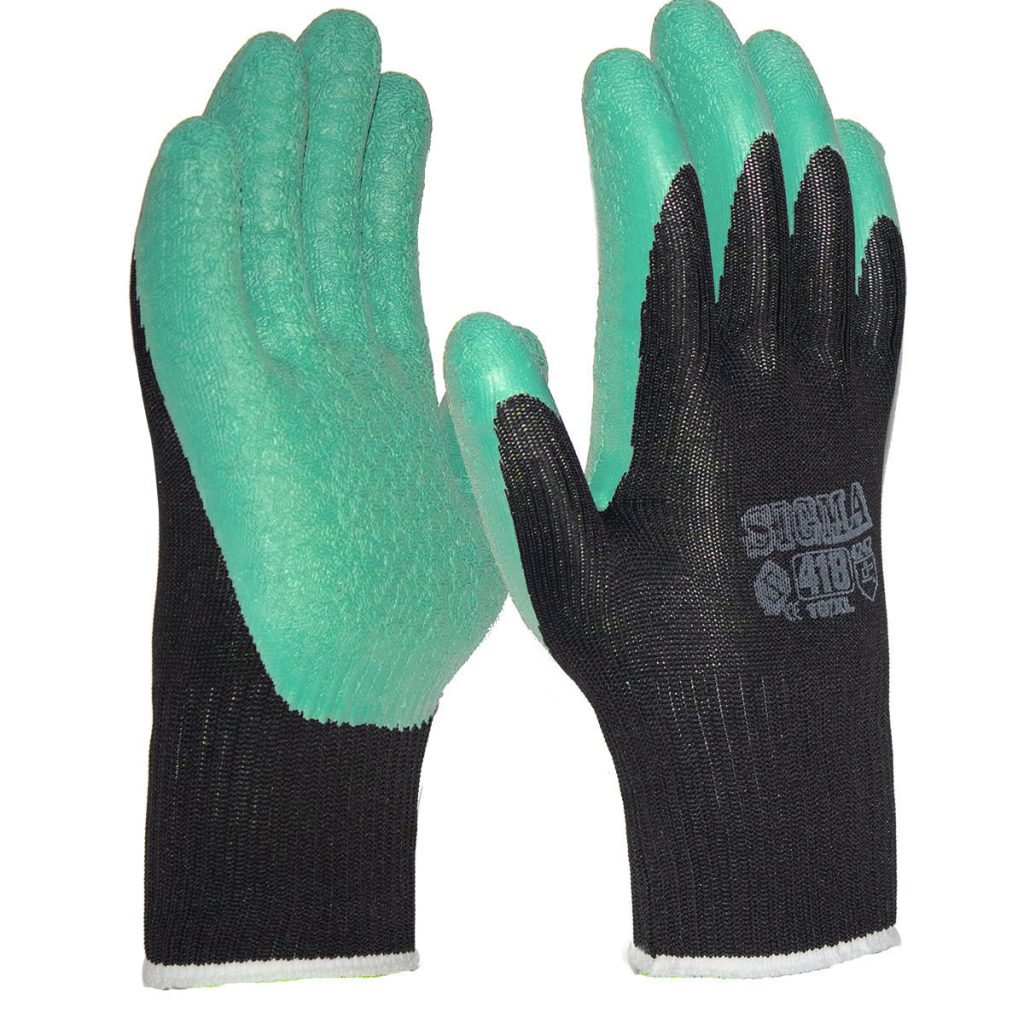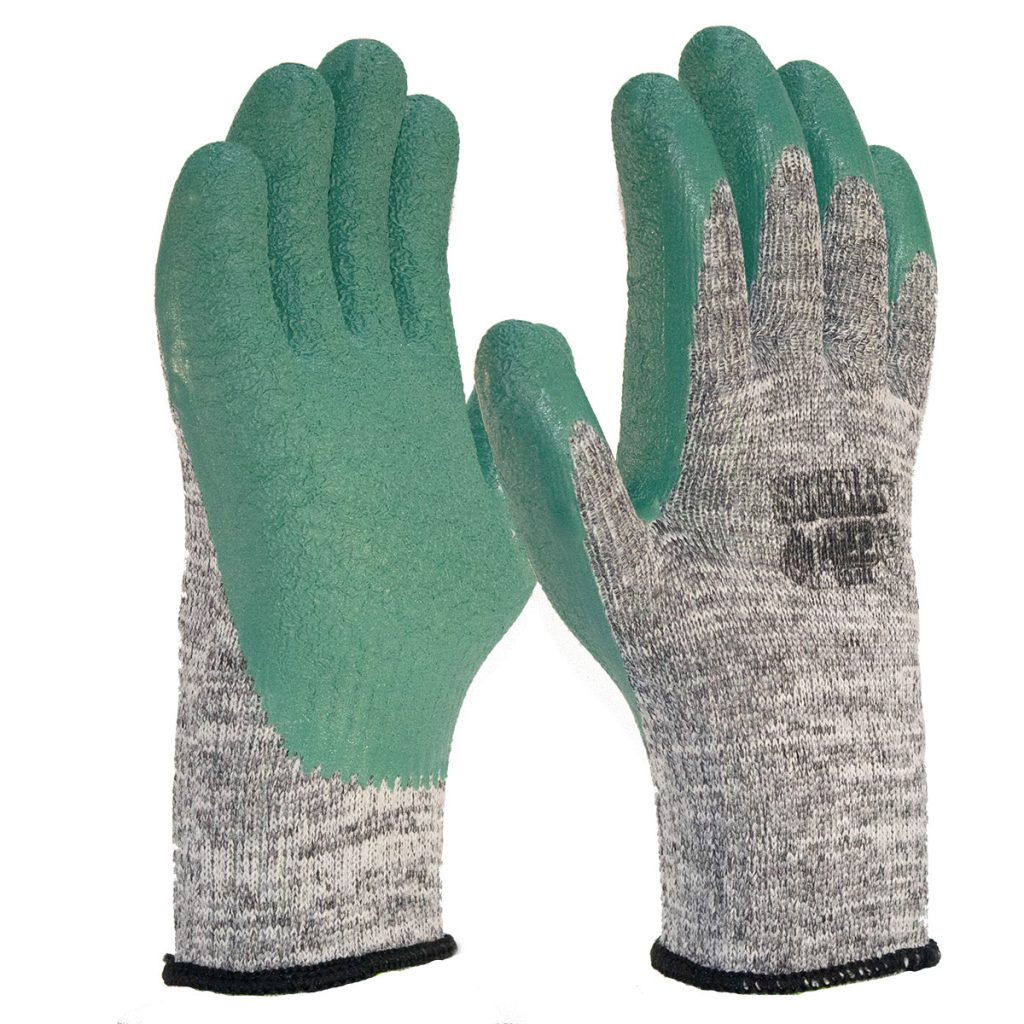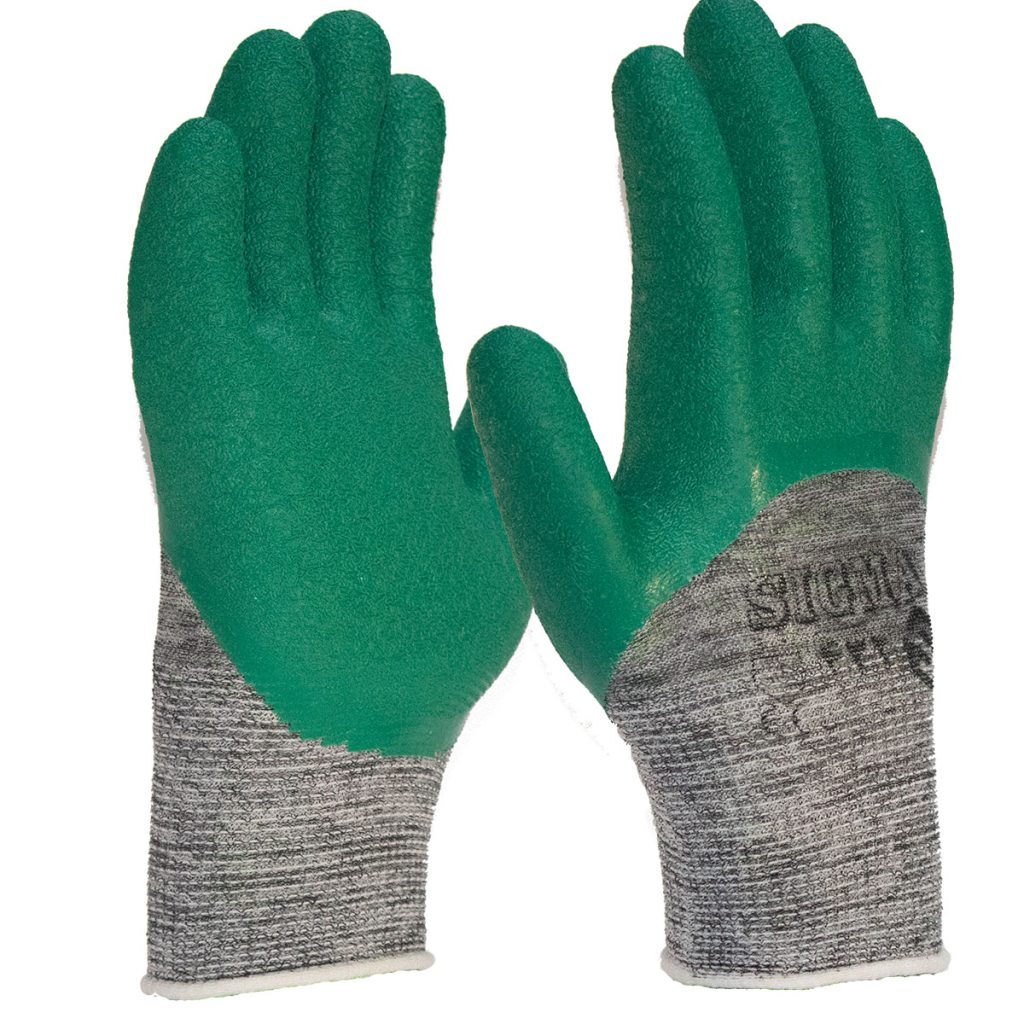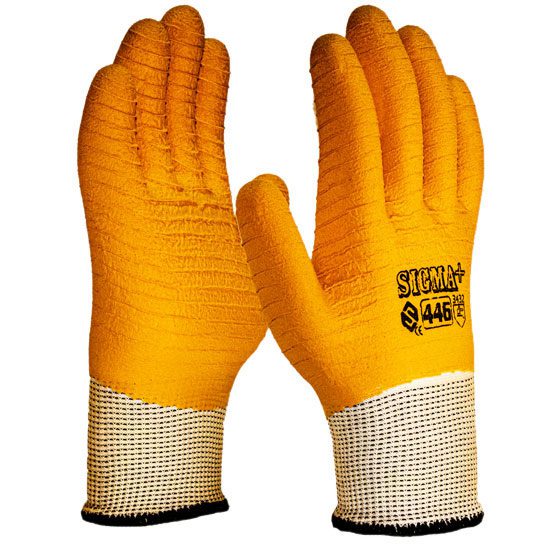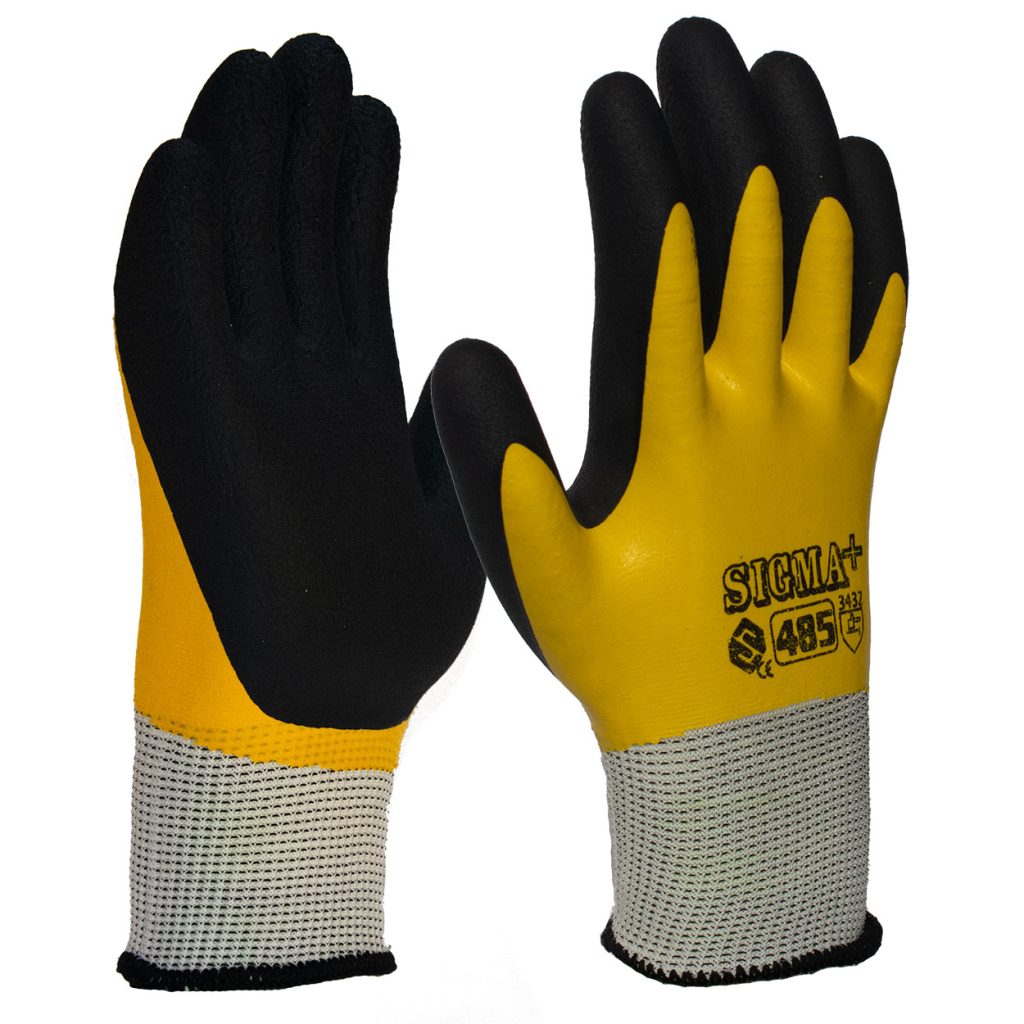Bricklaying gloves
Bricklaying Latex Coated Gloves

Latex coated gloves are a popular choice for bricklaying tasks due to their excellent grip, flexibility, and dexterity. They provide protection to the hands against abrasions, cuts, and punctures while handling bricks, mortar, and other materials. Here’s a brief overview of bricklaying latex coated gloves:
Features of Bricklaying Latex Coated Gloves:
1. Material: These gloves are typically made of a seamless knitted liner, such as cotton, polyester, or nylon, with a latex coating on the palm and finger areas. The liner provides comfort and breathability, while the latex coating ensures a strong grip and protection.
2. Grip: The latex coating offers excellent grip in both wet and dry conditions, making it easier to handle bricks, tools, and other materials used in bricklaying tasks.
3. Protection: The latex coating provides resistance against abrasions, cuts, and punctures, protecting the hands from injuries while working with bricks and other rough materials.
4. Dexterity and Flexibility: The gloves allow for natural hand movement, ensuring a high level of dexterity and flexibility for precise work and better control over tools and materials.
5. Sizes: Bricklaying latex coated gloves are available in various sizes to fit different hand shapes and sizes. It’s important to choose the correct size for a snug and comfortable fit, ensuring optimal protection and grip.
6. Cuffs: Many gloves feature an elastic or knit wrist cuff, which helps keep the gloves in place and prevents debris from entering.
When purchasing bricklaying latex coated gloves, consider factors such as the type of work you’ll be doing, the level of protection you need, and the fit and comfort of the gloves. It’s essential to choose high-quality gloves from a reputable manufacturer to ensure optimal performance and durability.
Construction latex coated gloves
Construction latex coated gloves are a type of protective glove that is designed for use in the construction industry. These gloves are made from latex rubber and are coated with a layer of rubber or PVC on the palms and fingers to provide added grip and protection.
Construction latex coated gloves are used by workers in a variety of construction trades, including carpentry, plumbing, electrical work, and general construction. They are commonly used for tasks such as handling rough building materials, operating power tools, and performing general maintenance and repairs.
One advantage of construction latex coated gloves is that they are typically more affordable than other types of protective gloves, such as leather or synthetic gloves. They are also lightweight and flexible, which allows for greater dexterity and sensitivity when handling tools and materials.
However, it is important to note that latex gloves can cause allergic reactions in some people, so it’s important to choose an alternative material if you have a latex allergy. Additionally, construction latex coated gloves may not be suitable for all types of construction work, as they may not provide sufficient protection against certain types of hazards.
Overall, construction latex coated gloves can be a cost-effective and practical option for construction workers who need added grip and protection when handling rough building materials and operating power tools
Important Features About Coated Bricklaying Latex Gloves
When choosing coated bricklaying latex gloves, there are several important features to consider to ensure that they provide adequate protection and comfort for the wearer. Here are some key features to look for:
1. Coating material: The coating on the gloves should be made from a durable material, such as PVC or rubber, that provides a good grip and protection against abrasions, cuts, and punctures.
2. Thickness: The gloves should be thick enough to provide adequate protection against rough surfaces and sharp edges, but not so thick that they hinder dexterity or make it difficult to handle tools.
3. Size: It’s important to choose gloves that fit properly to ensure maximum protection and comfort. Gloves that are too small may be uncomfortable and restrict movement, while gloves that are too large may slip or slide around on the hands.
4. Flexibility: The gloves should be flexible enough to allow for dexterity and sensitivity when handling tools and materials. They should not be too stiff or rigid.
5. Comfort: The gloves should be comfortable to wear for extended periods of time, with features such as a soft lining and a comfortable fit.
6. Durability: The gloves should be durable enough to withstand the wear and tear of construction work, and should not easily tear or puncture.
7. Resistance to chemicals: If workers will be handling chemicals or other hazardous materials, it’s important to choose gloves that are resistant to these substances to prevent skin irritation or other health hazards.
By considering these features, you can choose coated bricklaying latex gloves that provide the necessary protection and comfort for your specific job requirements.
Common Uses for Latex-Coated Gloves in Construction and Building Work
Latex-coated gloves are commonly used in construction and building work for a variety of purposes. Some common uses include:
1. Handling rough materials: Latex-coated gloves provide excellent grip and protection when handling rough or abrasive materials such as concrete, bricks, and lumber.
2. Protection from chemicals: Latex-coated gloves are resistant to many chemicals and can protect hands from exposure to substances such as oils, acids, and solvents.
3. Handling tools and equipment: Latex-coated gloves provide protection and grip when using tools and equipment such as hammers, saws, and drills.
4. Protection from cuts and punctures: Latex-coated gloves can provide protection from cuts and punctures when handling sharp materials such as metal or glass.
5. Cleaning and maintenance: Latex-coated gloves are often used for cleaning and maintenance tasks such as washing and wiping down surfaces, cleaning tools and equipment, and handling cleaning chemicals.
6. Plumbing and electrical work: Latex-coated gloves can provide protection when working with plumbing and electrical systems, helping to prevent injury from exposure to water, electricity, or other hazards.
7. Painting and finishing work: Latex-coated gloves provide protection and grip when working with paints and finishes, helping to prevent spills and accidents.
Overall, latex-coated gloves are versatile and provide a high level of protection for hands in a variety of construction and building work applications.
Job Tasks in Construction that Require Cut-resistant Coated Gloves
There are several job tasks in construction that may require gloves made from cut-resistant materials to protect workers from the risk of cuts and punctures. Here are a few examples:
1. Metalworking: Workers who are involved in metalworking tasks such as welding, grinding, or cutting metal may be at risk of cuts and punctures from sharp metal edges or metal particles. Gloves made from cut-resistant materials such as Kevlar or stainless steel mesh can provide protection against these hazards.
2. Glass handling: Workers who handle glass sheets or panes may be at risk of cuts and punctures from broken or jagged edges. Gloves made from cut-resistant materials can provide protection against these hazards.
3. Demolition work: Workers involved in demolition work may be at risk of cuts and punctures from sharp debris or metal fragments. Cut-resistant gloves can provide protection against these hazards.
4. Landscaping and tree trimming: Workers in landscaping and tree trimming jobs may be at risk of cuts and punctures from sharp tools such as pruning shears or chainsaws. Gloves made from cut-resistant materials can provide protection against these hazards.
5. Masonry work: Workers involved in masonry work may be at risk of cuts and punctures from sharp tools or rough stone surfaces. Cut-resistant gloves can provide protection against these hazards.
Overall, any job task in construction that involves handling sharp tools, materials with sharp edges, or rough surfaces may require gloves made from cut-resistant materials to protect workers from the risk of cuts and punctures.
Cleaning Bricklaying Latex Coated
Cleaning bricklaying latex coated gloves is important to maintain their integrity and prolong their lifespan. Here are some general guidelines for cleaning bricklaying latex coated gloves:
1.Check the care label:Before cleaning your gloves, check the care label to see if there are any specific cleaning instructions or recommendations. Some gloves may require specific cleaning agents or methods.
2. Remove excess dirt and debris: Use a soft-bristled brush or a towel to remove any excess dirt and debris from the gloves. This will make it easier to clean them thoroughly.
3. Wash the gloves: Fill a sink or basin with warm water and add a small amount of mild detergent. Gently wash the gloves in the soapy water, taking care not to scrub too hard or wring them out forcefully.
4. Rinse thoroughly: Rinse the gloves thoroughly with clean water to remove all soap residue.
5. Dry the gloves: Gently squeeze out any excess water and hang the gloves to dry in a well-ventilated area. Do not place them in direct sunlight or use a dryer, as this can damage the latex coating.
6. Store the gloves: Once the gloves are completely dry, store them in a cool, dry place away from direct sunlight to prevent damage.
It’s important to note that some latex gloves may not be suitable for washing and may need to be disposed of after use. Be sure to check the care label or manufacturer’s instructions before attempting to clean your gloves.
Suitable Detergent to Clean Latex Coated Gloves
When cleaning bricklaying latex coated gloves, it’s important to use a mild detergent that is suitable for delicate materials. Here are a few options:
1. Mild dish soap: A mild dish soap, such as Ivory or Dawn, can be a good option for cleaning latex gloves. These soaps are designed to be gentle on hands and are effective at removing dirt and grime.
2. Laundry detergent: A mild laundry detergent, such as one designed for delicates or baby clothing, can also be used to clean latex gloves. Be sure to choose a detergent that does not contain any harsh chemicals or bleach.
3. Hand soap: A gentle hand soap can also be used to clean latex gloves. Look for a soap that is free from harsh chemicals and fragrances.
Regardless of the type of detergent you choose, be sure to use a small amount and avoid using any harsh chemicals or bleach that can damage the latex coating on the gloves. Rinse the gloves thoroughly with clean water after washing to remove all soap residue, and allow them to air dry completely before storing them.
What types of hazards may not be protected against by construction latex coated gloves?
While construction latex coated gloves can provide protection against many types of hazards commonly encountered in construction work, there are some hazards that they may not protect against. Here are a few examples:
- Chemical exposure: Latex gloves may not provide adequate protection against exposure to hazardous chemicals, as they are permeable to many chemicals. Workers should wear gloves made from materials that are specifically designed for chemical resistance when handling hazardous substances.
- Heat exposure: Latex gloves are not suitable for handling hot materials or working in high-temperature environments, as they can melt or burn. Workers should wear gloves made from heat-resistant materials, such as leather or synthetic fabrics, when working with hot materials.
- Electrical hazards: Latex gloves do not provide protection against electrical shocks or other electrical hazards. Workers should wear gloves made from insulating materials that are specifically designed for electrical work when working with live electrical circuits.
- Cuts and punctures: While latex gloves can provide some protection against cuts and punctures, they may not be as effective as gloves made from cut-resistant materials, such as Kevlar or Dyneema. Workers should wear gloves that are specifically designed for cut resistance when working with sharp tools or materials. It’s important for workers to assess the specific hazards associated with their job tasks and choose the appropriate gloves that provide adequate protection against those hazards. Employers should also provide training to workers on the proper selection and use of protective gloves to help prevent workplace injuries and illnesses.
What are some other types of gloves that may be suitable for construction work?
There are several types of gloves that may be suitable for construction work, depending on the specific tasks involved. Here are a few examples:
- Leather gloves: Leather gloves are a popular choice for construction workers because they are durable, offer excellent protection against abrasions, cuts, and punctures, and provide a good grip. They are also heat-resistant and can be used for welding or other tasks involving hot materials.
- Synthetic gloves: Synthetic gloves, such as those made from nylon, polyester, or other materials, are often used in construction work because they are lightweight, comfortable, and flexible. They can offer a good level of protection against abrasions and cuts, but may not be as durable as leather gloves.
- Cut-resistant gloves: Cut-resistant gloves are designed to protect against cuts and punctures from sharp tools or materials. They are often made from materials such as Kevlar, Dyneema, or other high-strength fibers, and can provide a high level of protection without sacrificing dexterity.
- Disposable gloves: Disposable gloves, such as those made from latex, nitrile, or vinyl, may be used in construction work to protect against contamination or exposure to hazardous materials. They are not designed for heavy-duty tasks, but can be useful for handling chemicals or other substances.
- Insulated gloves: Insulated gloves are designed to protect against cold temperatures and can be useful for construction work in cold climates. They are often made from materials such as leather or synthetic fabrics and are lined with insulation to keep hands warm. It’s important to choose the right type of glove for the specific tasks involved in construction work, and to ensure that they fit properly and provide adequate protection.

